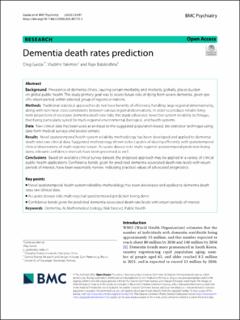| dc.contributor.author | Gaidai, Oleg | |
| dc.contributor.author | Yakimov, Vladimir | |
| dc.contributor.author | Balakrishna, Rajiv | |
| dc.date.accessioned | 2023-12-04T09:39:49Z | |
| dc.date.available | 2023-12-04T09:39:49Z | |
| dc.date.created | 2023-10-10T10:59:03Z | |
| dc.date.issued | 2023 | |
| dc.identifier.citation | Gaidai, O., Yakimov, V., & Balakrishna, R. (2023). Dementia death rates prediction. BMC psychiatry, 23(1), 691. | en_US |
| dc.identifier.issn | 1471-244X | |
| dc.identifier.uri | https://hdl.handle.net/11250/3105765 | |
| dc.description.abstract | Background
Prevalence of dementia illness, causing certain morbidity and mortality globally, places burden on global public health. This study primary goal was to assess future risks of dying from severe dementia, given specific return period, within selected group of regions or nations.
Methods
Traditional statistical approaches do not have benefits of effectively handling large regional dimensionality, along with nonlinear cross-correlations between various regional observations. In order to produce reliable long-term projections of excessive dementia death rate risks, this study advocates novel bio-system reliability technique, that being particularly suited for multi-regional environmental, biological, and health systems.
Data
Raw clinical data has been used as an input to the suggested population-based, bio-statistical technique using data from medical surveys and several centers.
Results
Novel spatiotemporal health system reliability methodology has been developed and applied to dementia death rates raw clinical data. Suggested methodology shown to be capable of dealing efficiently with spatiotemporal clinical observations of multi-regional nature. Accurate disease risks multi-regional spatiotemporal prediction being done, relevant confidence intervals have been presented as well.
Conclusions
Based on available clinical survey dataset, the proposed approach may be applied in a variety of clinical public health applications. Confidence bands, given for predicted dementia-associated death rate levels with return periods of interest, have been reasonably narrow, indicating practical values of advocated prognostics. | en_US |
| dc.language.iso | eng | en_US |
| dc.publisher | Springer Nature | en_US |
| dc.rights | Navngivelse 4.0 Internasjonal | * |
| dc.rights.uri | http://creativecommons.org/licenses/by/4.0/deed.no | * |
| dc.title | Dementia death rates prediction | en_US |
| dc.type | Peer reviewed | en_US |
| dc.type | Journal article | en_US |
| dc.description.version | publishedVersion | en_US |
| dc.rights.holder | © The Author(s) 2023 | en_US |
| dc.subject.nsi | VDP::Medisinske Fag: 700 | en_US |
| dc.source.volume | 23 | en_US |
| dc.source.journal | BMC Psychiatry | en_US |
| dc.source.issue | 1 | en_US |
| dc.identifier.doi | 10.1186/s12888-023-05172-2 | |
| dc.identifier.cristin | 2183255 | |
| cristin.ispublished | true | |
| cristin.fulltext | original | |
| cristin.qualitycode | 2 | |

